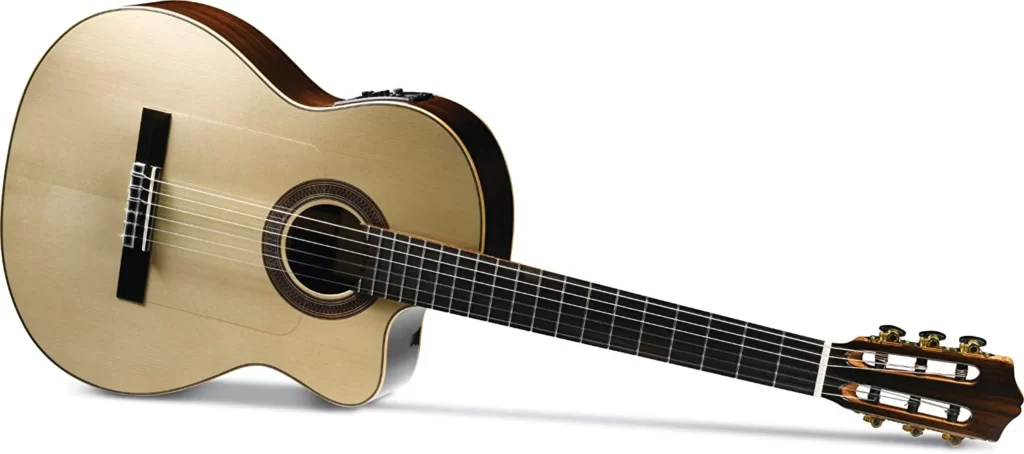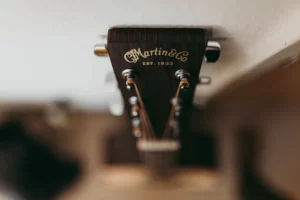After roaming around the internet for hours, you rarely find the original post related to Flamenco vs Classical guitars. That’s because both the guitars are somehow similar, but not 100%. Let’s read what the differences are. They have a sound difference even as flamenco and classical guitars appear remarkably similar on the exterior. Many distinctions between the two help them in achieving their specific aims.
The materials, depth, activity size, and sound of a classical and a flamenco guitar vary slightly. Classical guitars are mostly of cedar, whereas flamenco guitars are constructed of spruce. Flamenco guitars are lightweight and produce a buzzing sound more than classical guitars. This article will go over these distinctions and provide you with all the details you have to notice about the difference between a classical and a flamenco guitar.
If you want to know more about classical guitars, check out our reviews on the best classical guitars for beginners, in which we discuss some famous classical brands like Cordoba C5 and Yamaha C40. Our reviews of the best classical guitar under 500 & 1000 dollars, how to string a classical guitar and classical vs acoustic guitar are presently available as our featured articles, which may also be of interest to you.
Wood Components
To improve resilience, the experts construct classical guitars with spruce or wooden tops and rosewood or oak backs and edges. Such woods are brighter and can be seen through the guitar’s pale-skin side – part Blanca guitars are flamenco guitars. They are made from lighter-colored cedar or sycamore.
To increase weight, makers construct flamenco guitars with coniferous tree tops and cedar or maple back sides and side walls. The producers use cedar or oak as the wood for flamenco guitars, which results in a brighter and more energetic tone. The darker color creates a softer, more relaxing sound.
The constructors make the outer layers of classical guitars of darker woods. Such as cedar, Sapele, rosewood, or cedar. You will never get to see cypress or sycamore used for the bottom and sides of classical guitars. Thus, it indicates that the back and sides of classical guitars are often denser than that of flamenco guitars’ light color.
Creation
Classical guitar bodies are usually thicker, and the timber is thicker and more robust. Flamenco guitars get a loft or false (once connecting tension) neck relief, which allows for a fast movement at the expense of certain beeping. Flamenco chords are also nearer the body to enable mashing and frequently has a “golpeador,”. That is a polythene sheet installed toward the face of the musical instrument. To help shield the wrap-up.
Sound
The classical guitar intends to provide the performer with a toolkit. To manage polyphonic music, that may be needed “an orchestra in a package”. The strike is gentle with a slow and gradual deterioration. The makers make Flamenco guitars split through into the tone of choreographers stomping their feet.
The audio is slightly jazzy with a loud acoustic spurt followed by a fast decay.The variation in volume is genuinely so very noticeable. You can manage both guitars to play in the same hallway. It would most possibly muffle the tone of classical guitars. Flamenco guitars always have a more significant frequency than classical guitars.
Breadth and Strength
Classical guitars are heavier than flamenco guitars. Nevertheless, previous studies suggested that classical and flamenco guitars were much more lightweight. The wood used in Torres’ instruments (regardless of whether light or dark) was only 1.0 to 1.2 millimeters wide – half the thickness of present guitars, which are 1.5 to 3.0 mm thick.
According to Bruné, thicker tools of advanced sealers use industrial revolution techniques instead of the moment. Hand-applied French polish adds weight when interpreted as from the edge. The torso of a flamenco guitar has less intensity.
The confluence of factors (activity, golpeadores, peghead knobs, wood, mass, and intensity) distinguishes classical and flamenco guitars. But history indicates that they depend on cultural context rather than training.
A Way of Performing
They are suitable for smooth and relaxing sounds. You can play classical guitar very differently than flamenco guitar. Classical guitars are the best for performing classical music. Although the player can perform classical music at a fast pace, slow and delicate tempos are equally, if not even more, famous.
On the other hand, you can use flamenco guitars to hear music. That can encourage the audio of artists tapping their feet. This signifies that flamenco guitars require a more forceful, violent, and influential tone, which is perfect for the role. Flamenco guitars are seldom seen and, if ever, used for slow and soft tunes because the rhythm is often quick and loud.
Plate of Protection
Flamenco guitars involve a lot of fingertips swiping on the guitar’s body. It’s why flamenco guitars emerge with a polythene plate. These are placed on the upper end of the instrument. This thin plastic sheet is known as the golpeador. The addition of this side plate will protect the wrap-up of the musical instrument from pressing flamenco guitars.
Classical guitars, however, don’t even have scratching panels. Classical guitars would not require the player to strike the guitar to produce audio effects. Because the music that can play on classical guitars is smooth and gentle, any extra added noises besides the violins are undesirable.
Maintaining Posture
The classical guitar is traditionally held at a 45-degree angle from the equilibrium position. The guitar is on the left rather than the right, with only a sponsoring leg platform. Such as footstools to stabilize the posture. Classical guitarists of all levels often use such a handling placement — particularly those who compete internationally.
On the other hand, flamenco guitars are kept horizontally with the instrument parallel to the surface. For classical guitars, an instrument is placed near the leg rather than on the left. It is the most common place to hold a particular guitar. Such as flamenco guitars.
What Kinds of Guitars Must You Buy?
It is a perfectly reasonable question with a specific answer if you’re primarily willing to pursue the flamenco playing style. Although the noise has a Spanish taste and texture, a flamenco guitar can play any manner. This is always a good idea to do some research before going deep into the universe of flamenco guitar.
Is It Possible to Play Flamenco on a Classical Guitar?
You can play flamenco music on a classical guitar but it is not preferred. Flamenco music is generally loud and aggressive and rapid to accompany the choreographers’ quick smashing. That’s why the design of flamenco guitars has qualities and components. That produces a brighter tone and a more excellent sound.
The design of classical guitars is explicitly for melody. They are making their tone smooth and gentle. It thus tends to mean that playing flamenco music on classical guitars would create a lower part. And lighter noise than the optimum vibrant and loud density of flamenco guitars.
A further reason why you might be playing flamenco music on a classical guitar is that classical guitars don’t even have pressing panels. Among the most common Flamenco tools would be playing an instrument. At the same time, trying to tap the body to add a special effect to the tunes.
As a result, they frequently come with a tapping sheet to protect the instrument from damage done by nail tapping. Starting to play all these techniques on a “plate-less” classical guitar will strike the wrap-up in the long term.
Conclusion
In this post, you come to know a piece of vast information on flamenco vs classical guitar. Flamenco and classical guitars vary only slightly. However, even so, as you have seen in the post, minor differences could even quickly add up. You will not have the wrong musical instrument that now you realize which characteristics are encountered in which type. With this post, it will be easier for you to buy your preferred guitar.









